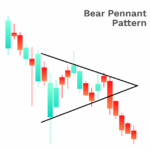
By ATGL
Updated March 26, 2024
Strategies that capitalize on the decline of security prices are as vital as those betting on their rise. Two prominent bearish strategies are short selling and purchasing put options. Both approaches offer investors a pathway to profit from a downturn in stock prices, yet they operate on fundamentally different principles and entail distinct risk profiles. This article delves into the nuances of short selling vs puts, providing investors with a comprehensive understanding of these options to navigate bear markets effectively.
Bearish Strategies Explained
What Is Short Selling and How Does It Work?
Short selling is an investment strategy used by investors who anticipate a decline in the price of a stock or other securities. It involves borrowing shares from a broker and selling them on the open market at their current price. The investor then aims to buy back the same number of shares at a lower price in the future. If successful, the investor returns the borrowed shares to the broker, keeping the difference in price as profit.
The process of short selling is encapsulated in the formula: Profit = Selling Price – Buying Price.
For instance, if an investor shorts 100 shares of a company at $50 each and later buys them back at $40 each, the profit would be $(50 – 40) * 100 = $1,000.
However, short selling is accompanied by substantial risks. Since the potential rise in stock prices is unlimited, so is the potential loss for the investor. If the stock price increases, buying back the shares to return them to the broker will be more expensive, resulting in a loss for the short seller. Moreover, the investor is responsible for any dividends paid out while the shares are borrowed, adding to the trade cost.
What Are Put Options and How Do They Work?
Put options offer an alternative method for investors to speculate on the decline of a stock’s price, with potentially lower risk compared to short selling. A put option is a contract that gives the holder the right, but not the obligation, to sell a specified amount of an underlying asset at a predetermined price (strike price) within a specified timeframe.
The buyer of a put option pays a premium to the seller for this right. If the stock price falls below the strike price before the option expires, the holder can exercise the option to sell the stock at the strike price, purchasing the shares at the lower market price to realize a profit. The maximum profit achievable is limited to the strike price minus the cost of the option premium, should the stock price drop to zero.
The calculation for profit in a put option scenario is: Profit = Strike Price – Current Market Price – Premium Paid.
For example, if an investor purchases a put option with a strike price of $50 for a premium of $2 per share, and the stock price falls to $30, the profit would be $(50 – 30 – 2) * 100 = $1,800, assuming the contract covers 100 shares.
Put options provide investors with a way to profit from a stock’s decline without the need to borrow shares. The risk is limited to the premium paid for the option, making it a potentially less risky strategy than short selling. Additionally, put options can serve as a form of insurance for investors looking to hedge against potential losses in their portfolio.
Short Selling vs Puts: A Full Comparison
While short selling and purchasing put options offer investors strategies for profiting from a downturn in security prices, they differ significantly in execution, risk, and potential outcomes. This section provides a detailed comparison of these two strategies across various dimensions.
Underlying Asset Types
Short Selling: This strategy is predominantly used with stocks, although it can be applied to other asset types, such as bonds and commodities. The investor needs access to a brokerage that allows short selling and must have a margin account due to the inherent risks and borrowing involved.
Put Options: Put options can be bought for a broader range of assets, including stocks, indexes, and ETFs (Exchange-Traded Funds). This gives investors greater flexibility to speculate on or hedge against the decline in prices of various market segments.
Level of Risk and Profit Potential
Short Selling: The risk involved in short selling is theoretically unlimited, as there is no cap on how high a stock price can rise. Consequently, the potential loss can exceed the initial investment. However, the profit potential is also substantial; the asset’s price declines more as profits increase.
Put Options: The risk in buying put options is limited to the premium paid for the option. No matter how unfavorably the market moves against the position, the maximum loss is the cost of the option. The profit potential, while significant, is capped by the fact that an asset can only decrease to zero in value.
Volatility and Implied Volatility
Short Selling: Volatility can significantly impact short selling, with higher volatility increasing the risk of loss. Rapid price increases can lead to margin calls, requiring the investor to provide additional funds or close positions at a loss.
Put Options: Implied volatility—a measure of the market’s forecast of a likely movement in a security’s price—directly affects the cost of put options. Higher implied volatility typically increases option premiums, making put options more expensive and potentially reducing the strategy’s profitability.
Market Conditions
Short Selling: Short selling is most effective in bear markets or when a specific stock is expected to decline due to fundamental issues. However, it requires precise timing and close monitoring to avoid significant losses.
Put Options: Put options can be advantageous in both bear markets and volatile markets. They allow investors to profit from declines without needing to time the market perfectly, thanks to the predefined contract duration.
Liquidity and Execution
Short Selling: Executing a short sale requires finding a broker that has the shares to borrow, which can sometimes be challenging, especially for less liquid stocks. Execution speed and the ability to find shares can significantly impact the strategy’s success.
Put Options: Trading put options typically offers higher liquidity, especially for options on widely traded stocks and indexes. Execution is straightforward, as it involves purchasing contracts on the open market without the need for borrowing.
Costs and Time Decay
Short Selling: The costs involved include the borrowing fee (which varies based on the stock’s availability and demand) and interest on the margin account used to initiate the short sale. There is no time decay in short selling, but holding a position for a long time can increase costs significantly due to accruing interest.
Put Options: Besides the premium paid for the option, put options are subject to time decay (theta), meaning the value of the option decreases as it approaches expiration. This decay accelerates as the expiration date nears, making timing a crucial element in the strategy’s profitability.
Surpass Your Investment Objectives With Above the Green Line
Incorporating these strategies into your investment portfolio can offer valuable opportunities for profit and risk management in volatile or declining markets. However, a successful application demands in-depth knowledge, experience, and ongoing market analysis.
At Above the Green Line, we empower investors with the insights, tools, and strategies needed to navigate the complexities of the financial markets confidently. Our proprietary metrics and systematic models are designed to identify optimal buying and selling points, helping you optimize the timing of your trades and align with prevailing market trends. Whether your investment philosophy leans towards active trading or long-term holding, our resources can enhance your strategy’s effectiveness and help you achieve your investment objectives.
Unlock your investment potential and join a community of savvy investors today.





